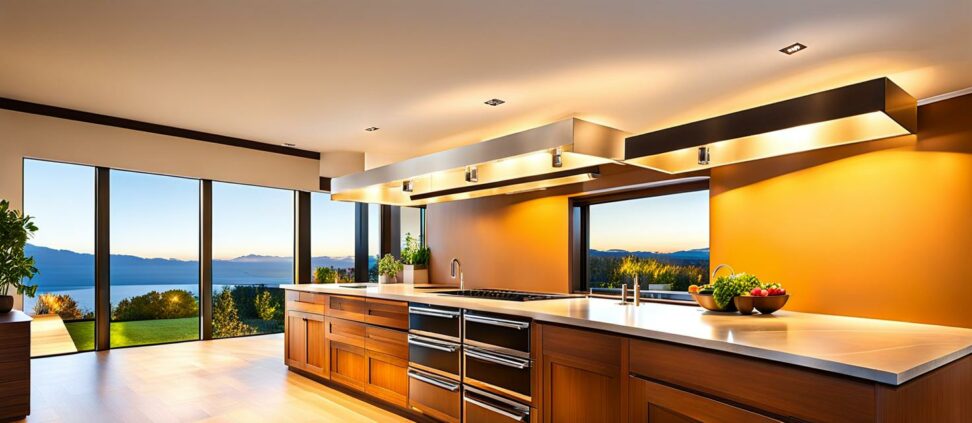overhead lights for kitchen - How to Make Your Kitchen Shine
The kitchen is often called the heart of the home. It's where families gather, meals are prepared, and memories are made. With so much time spent in the kitchen, having adequate and aesthetically pleasing overhead lighting should be a priority.
Overhead lighting serves both practical and decorative purposes. The right fixtures provide ample illumination for food prep, cooking, and cleaning up. Meanwhile, stylish pendants, chandeliers, and other light fixtures add character and complement your decor. Follow this guide for tips on choosing overhead lights to make your kitchen shine.
Assess Your Kitchen's Lighting Needs
When selecting overhead kitchen lighting, the first step is identifying your space's unique needs. Consider the size and layout of your kitchen along with how you use the space. This will help determine what type of lighting works best.

Consider Size and Layout
Small galley kitchens may only need a few recessed lights or flush mount fixtures. Larger open concept kitchens can handle bolder statements like a kitchen island chandelier. Measure your space and create a lighting plan for adequate coverage.
Pay attention to work zones like islands, counters, and the stove where task lighting is essential. Factor in ceiling height too. If you have high ceilings, larger-scale pendants and chandeliers can be stunning.
Think About Tasks and Activities
How do you use your kitchen? For entertaining? Cooking elaborate meals? Baking? Basic tasks like food prep require bright, focused task lighting. Ambient lighting sets a mood and illuminates the overall space.
Consider your lighting needs for various times of day. Bright lights for cooking or washing up after dinner. Softer glow for relaxing with coffee in the morning.
Identify Dark Zones
Look for dark corners or shadowed areas in your existing kitchen lighting layout. This is where additional lighting can make the biggest difference. Common problem spots include dining nooks, island counters, and underneath upper cabinets.
Targeted lighting transforms these formerly unlit spaces into brightly illuminated kitchen zones.
Popular Styles of Overhead Kitchen Lighting
When it comes to kitchen lighting fixtures, you have endless options to fit your functional needs and aesthetic taste. Here are some of the most popular overhead lighting styles.
Pendant Lights
Pendant lights mounted on the kitchen ceiling are a go-to choice. Island pendant lights in particular focus illumination right where you need it.
Drum pendants, mini pendants, or multi-light chandeliers work beautifully over islands. Go for full-sized pendants to light counters and dining areas.
Track Lighting
Track lighting offers incredible flexibility. Individual fixtures can be pointed where needed or moved along the track as needs change.
Linear track lighting provides focused task lighting. Cable track systems feature adjustable pendant lights. Tracks can be mounted on ceilings or walls.
Recessed Lighting
Recessed downlights, aka can lights, create ambient lighting and are unobtrusive. LED recessed kits are inexpensive and energy efficient. Rim and gimbal ring adjustability provide directional lighting.
Combine recessed lighting with pendants and under cabinet fixtures. Place recessed lights to eliminate dark corners.
Surface Mount Lights
For low kitchen ceilings, surface mounted lights are perfect. Flush mount ceilings fixtures provide soft, even light. Semi-flush options add interest.
Look for drum or bowl-shaped glass flush mounts to distribute light. Mini-pendants can also work on low ceilings.
Choose the Right Bulbs
The bulbs you choose have a big impact on the ambiance in your kitchen. Consider factors like brightness, color temperature, efficiency, and smart capabilities.
Lumens - Brightness Levels
Lumens indicate bulb brightness. For kitchen task lighting, look for 2500-4000 lumens. Under cabinet lights can be as low as 400-600 lumens.
Too many lumens creates glare. Not enough makes for dim, gloomy lighting. Balance task and ambient needs.
Kelvin Temperature
Kelvin refers to the light color. Lower kelvin (2700K-3000K) gives off warm yellow tones. Higher kelvins (5000K-6500K) emit cooler blue/white light.
For kitchens, stick with neutral white (3500K-4000K) or combine warm and cool lights to balance the space.
LED vs. Incandescent vs. Halogen
LED lights are super energy efficient and long lasting but can be pricey upfront. Incandescent lights are inexpensive but use lots more energy with shorter lifespans.
Halogen lights are powerful and bright, making them a good choice for task lighting. Consider pros and cons to pick what's right for your kitchen.
Smart Lighting Features
Many kitchen light fixtures now offer smart technology integration. Look for dimmable lights, color changing tuning, scheduling/automation options via app controls.
Smart lights add convenience like turning lights on before arriving home. Plus, you can create custom lighting scenes for different activities.
Complement Your Kitchen's Style
Kitchen lighting should blend seamlessly with your overall interior design. Choose overhead lighting that enhances and complements your decor.
Traditional Kitchens
For traditional kitchens, crystal chandeliers evoke elegance. Wrought iron and brass pendants nod to classic charm.
Cage pendants with fabric lampshades or lantern styles spaced along a kitchen island look stunning and provide task lighting.
Contemporary Kitchens
The clean lines of track lighting suit modern kitchens. Sleek drum pendants in polished metal, glass, or glossy finishes match the aesthetic.
Low-profile recessed lighting and spotlights highlight cooking zones without detracting from the minimalist style.
Rustic Kitchens
Play up the handcrafted charm of rustic kitchens with black wrought iron lighting. Antique pendants work beautifully. Exposed Edison bulbs and filament options complement the vintage vibe.
Opt for bronze finishes rather than polished chrome or nickel to enhance the natural elements.
Have fun mixing it up in eclectic kitchens. Combine modern track lights with retro pendants. Use an industrial cage fixture over a shabby chic table.
The key is finding balance between contrasting fixtures. Repeat finishes or materials to tie the look together.
With so many overhead kitchen lighting options, it can be tricky choosing the perfect fixtures that tick all the boxes for brightness, style, and functionality. Carefully consider your space, how you use your kitchen, and the look you want to achieve. With the right lighting choices, you can make your kitchen shine all day and night.